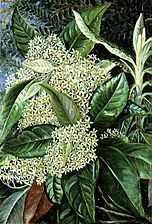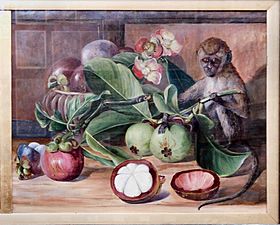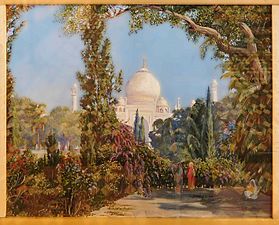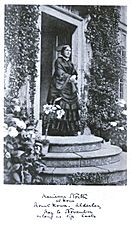Marianne North facts for kids
Quick facts for kids
Marianne North
|
|
|---|---|
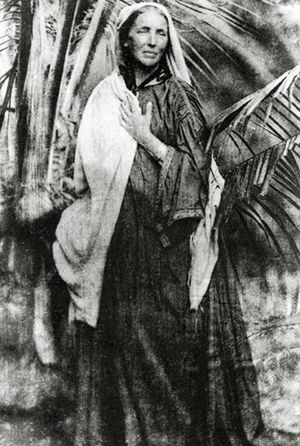
Marianne North at her home in Ceylon before 1879. Photographed by Julia Margaret Cameron.
|
|
| Born | 24 October 1830 Hastings, England
|
| Died | 30 August 1890 (aged 59) Alderley, Gloucestershire, England
|
| Parent(s) | Frederick North Janet Marjoribanks |
Marianne North (born October 24, 1830 – died August 30, 1890) was an amazing English artist and scientist from the Victorian era. She was famous for painting plants and landscapes, traveling all over the world, writing about her adventures, discovering new plants, and even creating her own art gallery at the Royal Botanic Gardens, Kew.
Contents
Early Life and Artistic Beginnings
Marianne North was born in Hastings, England. She was the oldest of three children in a wealthy family. Her father, Frederick North, was a Member of Parliament for Hastings. Her mother was Janet Marjoribanks.
Marianne first trained to be a singer. However, her voice was not strong enough, so she decided to focus on painting flowers instead. After her mother passed away in 1855, Marianne traveled a lot with her father. When her father died in 1869, she decided to follow her dream of painting plants from faraway countries.
A Passion for Plants and Travel
Marianne started painting flowers seriously after her mother's death in 1855. Her family lived in both Hastings and London. She became interested in plants, possibly because her father knew Sir Joseph Dalton Hooker. He was the director of the Royal Botanic Gardens, Kew.
Marianne painted her first landscape watercolors during a trip to Europe with her sister and father.
An Artist's Global Adventures
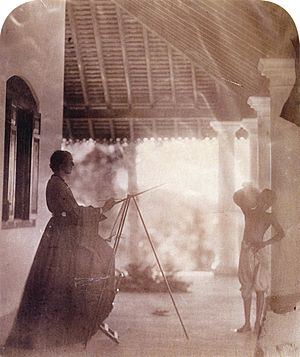
After her sister got married in 1864, Marianne and her father traveled even more. They visited Switzerland and the South Tyrol. From 1865 to 1867, they explored Syria and the Nile River. Sadly, her father became ill in 1869 and passed away. Marianne continued to paint to help with her sadness.
After her father's death, she traveled to Sicily and painted there. From 1871 to 1872, she visited Canada, the United States, and Jamaica. She also spent a year in Brazil, where she painted many works deep inside a forest. An artist named Frederic Edwin Church encouraged her to visit South America. She thought he was "the greatest of living landscape painters."
In 1875, after a few months in Tenerife, Marianne started a trip around the world. For two years, she painted the plants of California, Japan, Borneo, Java, and Ceylon. While in California, she worried about the destruction of the giant redwood trees. In 1878, she spent the whole year painting in different parts of India.
In 1878, a newspaper called The Graphic wrote about an exhibition of Marianne North's art in Kensington, London. Over 500 of her oil paintings were shown to the public. The newspaper praised her for her "freedom of hand, the purity and brilliancy of colour and the accurate draughtsmanship of a consummate artist."
The Marianne North Gallery
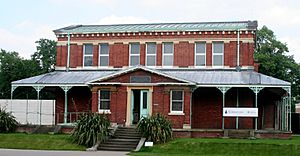
When Marianne returned to Britain, she showed many of her drawings in London. She offered to give her entire collection to the Royal Botanic Gardens at Kew. She also offered to build a special gallery to keep them. Kew Gardens accepted her generous offer. The new buildings, designed by James Fergusson, started being built that same year.
In 1880, Charles Darwin suggested that Marianne visit Australia. For a year, she painted plants there and in New Zealand. When she returned, she gave Darwin a shrub called 'Australian Sheep' (Raoulia eximia) as a gift. She also showed him her Australian paintings. Her paintings of Banksia attenuata, B. grandis, and B. robur were highly admired.
Her gallery at Kew Gardens officially opened in 1882. For the opening, 800 oil paintings on cardboard were displayed. These paintings showed twenty years of Marianne North's life and travels.
In 1883, after a trip to South Africa, where she visited artist Katharine Saunders, another room was added to the Kew gallery. From 1884 to 1885, Marianne worked in the Seychelles and in Chile. When she became too ill to travel, she moved to Alderley, Gloucestershire. She passed away there on August 30, 1890, and is buried in the local churchyard.
Marianne North's Lasting Impact
Marianne North's work is very important because of how accurately she painted plants from all over the world. She did this before photography became common. This makes her art very valuable for science.
Several plant species have been named in her honor. These include Areca northiana, Crinum northianum, Kniphofia northiae, Nepenthes northiana, and even a whole group of plants called Northia.
Kew Gardens says that the North Gallery is "the only permanent solo exhibition by a female artist in Britain." In 2008, Kew Gardens received a large grant from the National Lottery. This money helped them restore both the gallery and the paintings inside.
On September 26, 2016, the BBC 4 television channel showed a documentary called Kew's forgotten queen. This show told the amazing story of Marianne North's life.
Gallery
-
Nepenthes northiana (c. 1876), Marianne North Gallery, Kew Gardens. This painting shows the pitcher plant's lower and upper pitchers.
-
Olearia argophylla, Marianne North Gallery, Kew Gardens.
-
Water Palace - Chitore. India. Decr. 1878, British Library.
-
The Taj Mahal at Agra, North West India, Marianne North Gallery, Kew Gardens.
-
Photograph of North at her home in Mount House, Alderley c. 1867, taken by Mrs Susan Hodgson.
Images for kids
See also
 In Spanish: Marianne North para niños
In Spanish: Marianne North para niños




